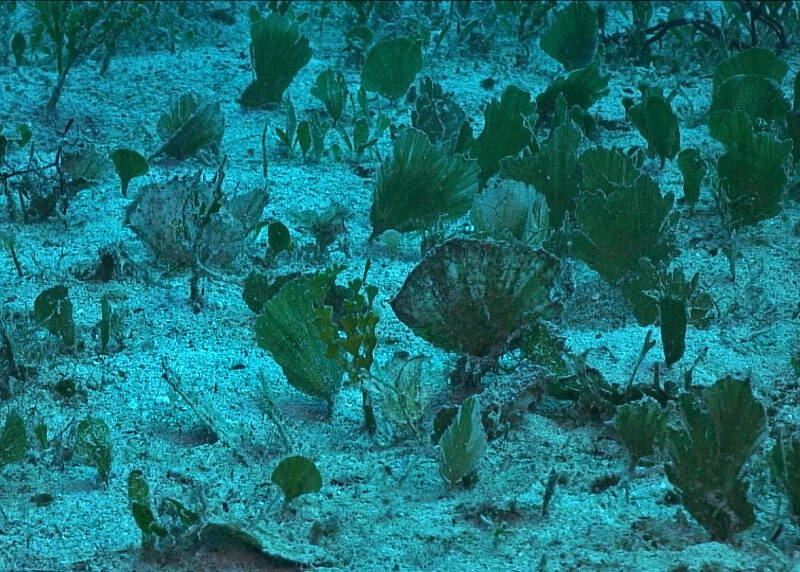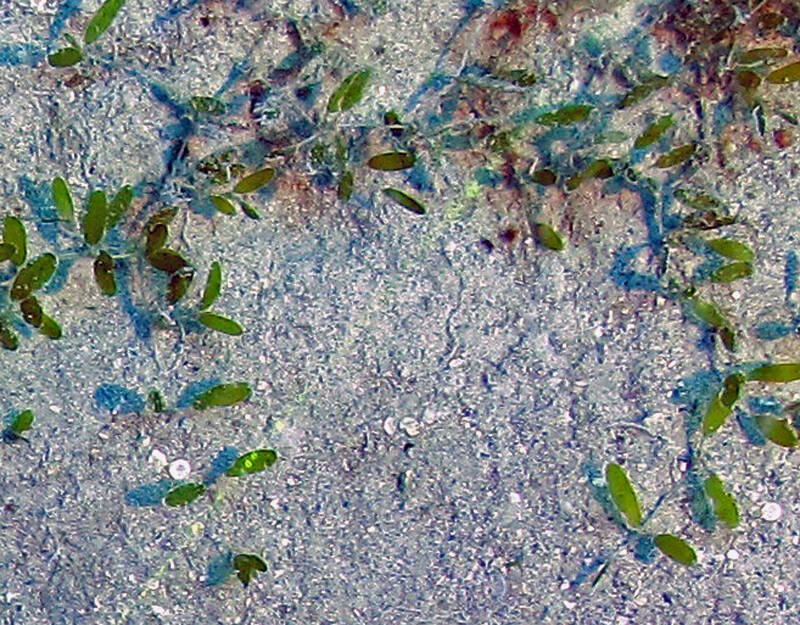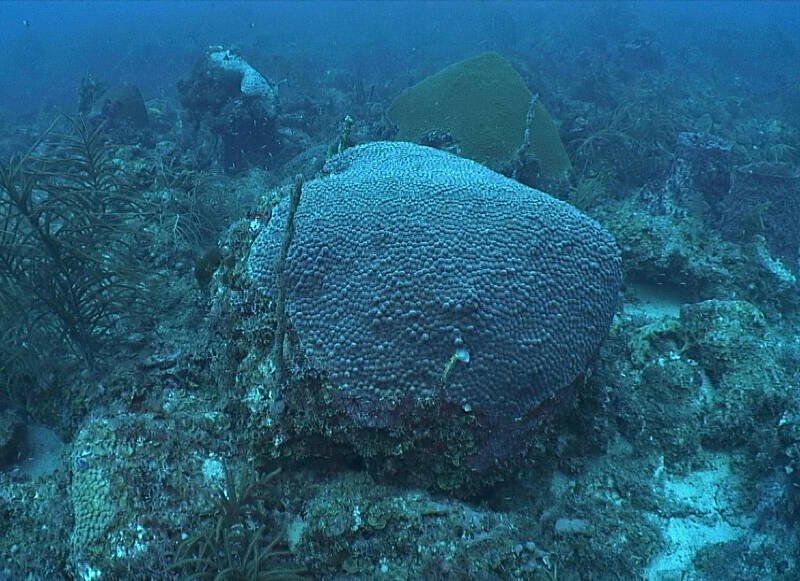
By M. Dennis Hanisak, The Cruise’s Chief Scientist and Research Professor - Florida Atlantic University – Harbor Branch
August 25, 2014
We were not the only ones exploring this Halophila bed in the Tortugas. Conch live in seagrass meadows and eat small organisms living on seagrass blades. Video courtesy of Coral Ecosystem Connectivity 2014 Expedition. Download (mp4, 2.7 MB)
We humans like to take notice of events that end in two zeros. Today we had such an event. It was the 100th dive of the Mohawk remotely operated vehicle (ROV) operated by the University of North Carolina at Wilmington’s Undersea Vehicles Program.

Sand plains, dominated by macroalgae, are commonly found near coral reefs in the Tortugas. The dominant organisms of the sand plains are macroalgae, primarily chlorophytes (green algae) including calcified species, like Udotea, Penicillus, and Halimeda, and the uncalcified Caulerpa. Image courtesy of Coral Ecosystem Connectivity 2014 Expedition. Download larger version (jpg, 1.1 MB).
Today, we are diving off the Tortugas Ecological Reserve, a marine protected area under the jurisdiction of NOAA’s Florida Keys National Marine Sanctuary.
Officially for us, this was the 21st Mohawk ROV dive of our 2014 cruise, but our ROV team, consisting of Lance Horn and Jason White, were clearly looking forward to this milestone of 100 dives. Lance and Jason have been working with this new ROV for almost a year, first prepping it for scientific missions, and then piloting it on several other scientific cruises. Like any new piece of technologically sophisticated equipment, there was a learning curve, followed by troubleshooting and fine tuning.
As with our dives on Pulley Ridge, we seek a better characterization of the benthic community and biological resources of the Tortugas area and ultimately an understanding of the connectivity between the communities of Pulley Ridge and the Tortugas. Our operating depth today is 30 meters, shallower than our Pulley dives. Thus, the Mohawk’s 100th dive was spent in a soft-bottom area that I would call a sand flat.
The primary benthic cover is macroalgae, primarily chlorophytes (green algae) including species of Caulerpa, Udotea, Penicillus, and Halimeda. Now these are not what most people (or biologists) would consider terribly charismatic organisms, but they are of great interest to me, as I am a phycologist (one who studies algae). And like Pulley Ridge, this site is also dominated by algae!

Despite its small size (plants are less 1-2.5 centimeters tall), the seagrass Halophila decipens is ecologically important as a primary producer, habitat, and stabilizer of sediment. Image courtesy of Coral Ecosystem Connectivity 2014 Expedition. Download larger version (jpg, 1.0 MB).
As my eye begins to focus a little better on the photographs I am taking with the Mohawk’s camera and then on the high-definition video of our transects, I realize that there is something else here…something that I have wanted to see at these depths in the Tortugas for a long time.
At first, I think I am seeing a small species of Caulerpa, but on closer examination, it is clear that the species I am looking at is Halophila decipens, a diminutive species of seagrass. This species is typically found in much shallower water, such as the Indian River Lagoon along the east coast of Florida, where I do most of my research. I have seen this species on occasion at deeper depths in the Caribbean off coral reefs on extensive sand flats like the ones we found today. I have been aware for a long time of old reports of Halophila decipens in the Tortugas growing to 90 meters deep, which is incredible for a vascular plant, which has a higher light requirement than most algae. So, you can imagine my excitement when I actually saw it for the first time.

Not far away from the sand plains of our first two dives of the day, we found a diverse coral reef dominated by the hard coral, Montastraea cavernosa. While this habitat may appear to be very different from the sand plains dominated by seagrass, some species of fish and crustaceans regularly move back and forth between the two habitats. Image courtesy of Coral Ecosystem Connectivity 2014 Expedition. Download larger version (jpg, 848 KB).
In slightly deeper water, we see even more extensive Halophila meadows. Despite its small stature, this seagrass is important in stabilizing sediments, making them more suitable for colonization by other plants and animals. Halophila is readily eaten by certain animals including endangered sea turtles.
While we see no sign of any large grazers in this community, there is no doubt that this tiny plant is serving an important role in terms of primary productivity and habitat.
Mohawk dive #102 is near Riley’s Hump at a location just a couple of hundred meters from the Sanctuary’s western boundary. We do not need a chart to know where that boundary was; from the deck of the R/V Walton Smith, we see a row of lobster traps deployed in a long line just outside the Sanctuary’s border. The traps cannot be used in the Sanctuary, but clearly someone thought it was a good strategy to hunt for lobsters as close as they could to those protected waters. Unlike our first two dives today, this one reveals a very nice coral reef with high coral diversity and coverage, much appreciated by the biologists on our team.
No two of our dives are ever the same. We routinely encounter unexpected organisms or poorly understood phenomenon. On our cruise last year, we retired the Mohawk’s predecessor, the Super Phantom ROV, which made a career 2,298 dives. While the Mohawk has a long way to go to reach that milestone, it is safe to say that after its first 100 dives, it has proven to be a considerable upgrade over the Super Phantom. We look forward to working with Lance and Jason for many more missions in the future!